A Numerical Investigation of the Influence of the Wake for Mixed Layout Wind Turbines in Wind Farms Using FLORIS †
Abstract
:1. Introduction
2. Materials and Methods
2.1. FLORIS Overview
2.2. Case Setup
3. Results
3.1. Impact of Whole-Farm Power Output
3.1.1. Output for Two Wind Turbines Lined up in a Parallel Row
3.1.2. Output for Whole-Farm of Parallel Arrangement
3.1.3. Output for Whole-Farm of Staggered Arrangement
3.1.4. Overall Analysis
3.2. Impact of Wind Turbine Replacement on Its Downstream Turbines
3.2.1. Output for Each Column of Parallel Arrangement
3.2.2. Output for Each Turbine of Staggered Arrangement
4. Conclusions
- (1)
- The impact of different replacement schemes for wind turbines on output power is greater when the replacement wind turbine is situated in the middle of the original wind farm. This is due to the greater influence of the wake effect. Furthermore, the wake generated by the replacement wind turbine has a greater impact on the subsequent wind turbines. For example, replacing one wind turbine results in a reduction of 1.772 MW in output power compared to the optimal replacement scheme at a wind speed of 11 m/s. Furthermore, the discrepancy in power increases with the addition of replacement units. The implementation of an optimal replacement scheme can mitigate the impact of the tail current during the replacement process of a wind farm, thereby enhancing the economic viability of the wind farm.
- (2)
- In the event of a wind turbine requiring replacement, those situated in a straight row will be replaced in the direction of the incoming wind from the wind farm. The last row of the wind farm will then be considered as a replacement point for the large wind turbine. In the case of a wind farm comprising a series of staggered rows, priority shall be accorded to the installation of a large wind turbine in the diagonal area of the wind farm. Furthermore, no other wind turbines shall be situated behind the point corresponding to this diagonal area. Secondly, consideration shall be given to setting the point corresponding to the first column of the wind turbine of the entire wind farm as the replacement point for the large wind turbine.
- (3)
- In the actual situation, the arrangement of wind turbines in the wind farm does not necessarily follow the full row or the wrong row, or follow the above two methods of arranging the wind turbines. At this time, consideration should be given to the positioning of large wind turbines in order to achieve a comprehensive solution. This should be conducted in a way that brings the large wind turbines closer to the upstream of the wind farm, while simultaneously ensuring that the number of turbines behind them is kept to a minimum.
- (4)
- In light of the findings presented in this paper, the authors’ team also identified a potential solution to mitigate the impact of wake effects on small wind turbines downstream of replacement points. This can be achieved by lifting the hub center height of the large wind turbine, which may help to prevent a decrease in the power output. By reducing the overlap of the projected areas of the wind wheels of the small and large wind turbines in the direction of the incoming wind as much as possible, the overall power generation of the WTGs can be increased.
Author Contributions
Funding
Institutional Review Board Statement
Informed Consent Statement
Data Availability Statement
Conflicts of Interest
References
- Cao, J.; Nyborg, C.M.; Feng, J.; Hansen, K.S.; Bertagnolio, F.; Fischer, A.; Sørensen, T.; Shen, W.Z. A new multi-fidelity flow-acoustics simulation framework for wind farm application. Renew. Sustain. Energy Rev. 2022, 156, 111939. [Google Scholar] [CrossRef]
- Wang, Q.; Luo, K.; Wu, C.; Tan, J.; He, R.; Ye, S.; Fan, J. Inter-farm cluster interaction of the operational and planned offshore wind power base. J. Clean. Prod. 2023, 396, 136529. [Google Scholar] [CrossRef]
- Yan, R.; Wang, J.; Huo, S.; Qin, Y.; Zhang, J.; Tang, S.; Wang, Y.; Liu, Y.; Zhou, L. Flexibility improvement and stochastic multi-scenario hybrid optimization for an integrated energy system with high-proportion renewable energy. Energy 2023, 263, 125779. [Google Scholar] [CrossRef]
- Zhang, L.; Li, J.; Xu, X.; Liu, F.; Guo, Y.; Yang, Z.; Hu, T. High spatial granularity residential heating load forecast based on Dendrite net model. Energy 2023, 269, 126787. [Google Scholar] [CrossRef]
- Xu, X.; Hu, S.; Shi, P.; Shao, H.; Li, R.; Li, Z. Natural phase space reconstruction-based broad learning system for short-term wind speed prediction: Case studies of an offshore wind farm. Energy 2023, 262, 125342. [Google Scholar] [CrossRef]
- Notice of the National Energy Administration Prints Measures for the Management of Wind Farm Renovation, Upgrading and Decommissioning. Available online: https://www.gov.cn/gongbao/2023/issue_10626/202308/content_6897055.HTML (accessed on 5 June 2023).
- Wu, C.; Wang, Q.; Luo, K.; Fan, J. A coupled turbine-interaction wind farm parameterization in the Weather Research and Forecasting model. Energy Convers. Manag. 2023, 283, 116919. [Google Scholar] [CrossRef]
- Wang, Q.; Luo, K.; Wu, C.; Mu, Y.; Tan, J.; Fan, J. Diurnal impact of atmospheric stability on inter-farm wake and power generation efficiency at neighboring onshore wind farms in complex terrain. Energy Convers. Manag. 2022, 267, 115897. [Google Scholar] [CrossRef]
- Xu, X.; Hu, S.; Shao, H.; Shi, P.; Li, R.; Li, D. A spatio-temporal forecasting model using optimally weighted graph convolutional network and gated recurrent unit for wind speed of different sites distributed in an offshore wind farm. Energy 2023, 284, 128565. [Google Scholar] [CrossRef]
- Yang, M.; Guo, Y.; Huang, Y. Wind power ultra-short-term prediction method based on NWP wind speed correction and double clustering division of transitional weather process. Energy 2023, 282, 128947. [Google Scholar] [CrossRef]
- Xu, X.; Li, B.; Qiao, Z.; Shi, P.; Shao, H.; Li, R. Caputo-Fabrizio fractional order derivative stochastic resonance enhanced by ADOF and its application in fault diagnosis of wind turbine drivetrain. Renew. Energy 2023, 219, 119398. [Google Scholar] [CrossRef]
- Chamorro, L.P.; Tobin, N.; Arndt, R.; Sotiropoulos, F. Variable-sized wind turbines are a possibility for wind farm optimization. Wind Energy 2014, 17, 1483–1494. [Google Scholar] [CrossRef]
- Porté-Agel, F.; Wu, Y.T.; Chen, C.H. A numerical study of the effects of wind direction on turbine wakes and power losses in a large wind farm. Energies 2013, 6, 5297–5313. [Google Scholar] [CrossRef]
- Tian, W.; Ozbay, A.; Wang, X.D.; Hu, H. Experimental investigation on the wake interference among wind turbines sited in atmospheric boundary layer winds. Acta Mech. Sin. 2017, 33, 742–753. [Google Scholar] [CrossRef]
- Zhu, Y.; Guo, Y.; Hu, T.; Wu, C.; Zhang, L. Wind Farm Layout Optimization Based on Dynamic Opposite Learning-Enhanced Sparrow Search Algorithm. Int. J. Energy Res. 2024, 2024, 4322211. [Google Scholar] [CrossRef]
- Ma, Y.; Liu, Y.; Bai, X.; Guo, Y.; Yang, Z.; Wang, L.; Tao, T.; Zhang, L. Divide Merge: A Multi-Vessel Optimization Approach for Cooperative Operation and Maintenance Scheduling in Offshore Wind Farm. Renew. Energy 2024, 229, 120758. [Google Scholar] [CrossRef]
- Zhang, L.; Feng, Z.; Zhao, Y.; Xu, X.; Feng, J.; Ren, H.; Zhang, B.; Tian, W. Experimental study of wake evolution under vertical staggered arrangement of wind turbines of different sizes. J. Mar. Sci. Eng. 2024, 12, 434. [Google Scholar] [CrossRef]
- Zhang, L.; Feng, Z.; Pan, P.; Liang, J.; Tian, W.; Zhao, X.; Shen, K.; Zhang, P.; Chen, Y.; Song, C. Experimental study on the periodicity of wake flow of a vertical staggered wind turbine fleet. Ocean Eng. 2024, 309, 118471. [Google Scholar] [CrossRef]
- Shi, P.; Lin, S.; Song, D.; Xu, X.; Wu, J. TRNet: A trend and residual network utilizing novel hilly attention 1 mechanism for wind speed prediction in complex scenario. Energy 2024, 309, 133103. [Google Scholar] [CrossRef]
- Zhang, L.; Yang, Z.; Tian, S.; Li, W.; Chen, G. Front Deflector Effects on the Aerodynamic Characteristics of Horizontal Axis Wind Turbines: A Reynolds-Averaged Navier–Stokes Simulation Study. Energy Technol. 2024, 2400556. [Google Scholar] [CrossRef]
- Tong, G.; Li, Y.; Tagawa, K.; Feng, F. Effects of blade airfoil chord length and rotor diameter on aerodynamic performance of straight-bladed vertical axis wind turbines by numerical simulation. Energy 2023, 265, 126325. [Google Scholar] [CrossRef]
- Xie, S.; Archer, C.L.; Ghaisas, N.; Meneveau, C. Benefits of collocating vertical-axis and horizontal-axis wind turbines in large wind farms. Wind Energy 2017, 20, 45–62. [Google Scholar] [CrossRef]
- Chen, J.; Zhang, Y.; Xu, Z.; Li, C. Flow characteristics analysis and power comparison for two novel types of vertically staggered wind farms. Energy 2023, 263, 126141. [Google Scholar] [CrossRef]
- Chen, K.; Song, M.; Zhang, X.; Wang, S. Wind turbine layout optimization with multiple hub height wind turbines using greedy algorithm. Renew. Energy 2016, 96, 676–686. [Google Scholar] [CrossRef]
- Wang, L. Comparative study of wind turbine placement methods for flat wind farm layout optimization with irregular boundary. Appl. Sci. 2019, 9, 639. [Google Scholar] [CrossRef]
- Gebraad, P.M.; Teeuwisse, F.W.; Van Wingerden, J.W.; Fleming, P.A.; Ruben, S.D.; Marden, J.R.; Pao, L.Y. Wind plant power optimization through yaw control using a parametric model for wake effects—A CFD simulation study. Wind Energy 2016, 19, 95–114. [Google Scholar] [CrossRef]
- Van Beek, M.T.; Viré, A.; Andersen, S.J. Sensitivity and uncertainty of the FLORIS model applied on the Lillgrund wind farm. Energies 2021, 14, 1293. [Google Scholar]
- Cioffi, A.; Muscari, C.; Schito, P.; Zasso, A. A steady-state wind farm wake model implemented in OPENFAST. Energies 2020, 13, 6158. [Google Scholar] [CrossRef]
- Zhao, L.; Xue, L.; Li, Z.; Wang, J.; Yang, Z.; Xue, Y. Progress on offshore wind farm dynamic wake management for energy. J. Mar. Sci. Eng. 2022, 10, 1395. [Google Scholar] [CrossRef]
- Zhang, J.; Zhao, X. Quantification of parameter uncertainty in wind farm wake modeling. Energy 2020, 196, 117065. [Google Scholar] [CrossRef]
- Kütükçü, G.; Uzol, O. Monte Carlo simulations based hub height optimization using FLORIS for two interacting onshore wind farm. J. Renew. Sustain. Energy 2022, 14, 063304. [Google Scholar] [CrossRef]
- Sinner, M.; Simley, E.; King, J.; Fleming, P.; Pao, L.Y. Power increases using wind direction spatial filtering for wind farm control: Evaluation using FLORIS, modified for dynamic settings. J. Renew. Sustain. Energy 2021, 13, 023310. [Google Scholar] [CrossRef]
- Doekemeijer, B.M.; van der Hoek, D.; van Wingerden, J.W. Closed-loop model-based wind farm control using FLORIS under time-varying inflow conditions. Renew. Energy 2020, 156, 719–730. [Google Scholar] [CrossRef]
- Fleming, P.; Annoni, J.; Shah, J.J.; Wang, L.; Ananthan, S.; Zhang, Z.; Hutchings, K.; Wang, P.; Chen, W.; Chen, L. Field test of wake steering at an offshore wind farm. Wind Energy Sci. 2017, 2, 229–239. [Google Scholar] [CrossRef]
- Ramírez Castillo, S.A. Engineering Models Enhancement for Wind Farm Wake Simulation and Optimization. Master’s Thesis, ING-School of Industrial and Information Engineering, Milano, Italy, 2019. [Google Scholar]
- Qian, G.W.; Ishihara, T. Wind farm power maximization through wake steering with a new multiple wake model for prediction of turbulence intensity. Energy 2021, 220, 119680. [Google Scholar] [CrossRef]
- Bastankhah, M.; Porté-Agel, F. A New Analytical Model for Wind-Turbine Wakes. Renew. Energy 2014, 70, 116–123. [Google Scholar] [CrossRef]
- Niayifar, A.; Porté-Agel, F. A New Analytical Model for Wind Farm Power Prediction. J. Phys. Conf. Ser. IOP Publ. 2015, 625, 012039. [Google Scholar] [CrossRef]
- Crespo, A.; Herna, J. Turbulence Characteristics in Wind-turbine Wakes. J. Wind Eng. Ind. Aerodyn. 1996, 61, 71–85. [Google Scholar] [CrossRef]
- Wang, J.; Ouyang, R.; Wen, W.; Wan, X.; Wang, W.; Tolba, A.; Zhang, X. A post-evaluation system for smart grids based on microservice framework and big data analysis. Electronics 2023, 12, 1647. [Google Scholar] [CrossRef]
- Sensi, L.; Melani, P.; Venturi, A.; Giusti, M.; Mungo, G.; Tomassetti, V.; Bianchini, A. Re-Powering Italian Wind Farms: A Feasibility Study from Theory to Practice. J. Phys. Conf. Ser. IOP Publ. 2022, 2385, 012107. [Google Scholar] [CrossRef]
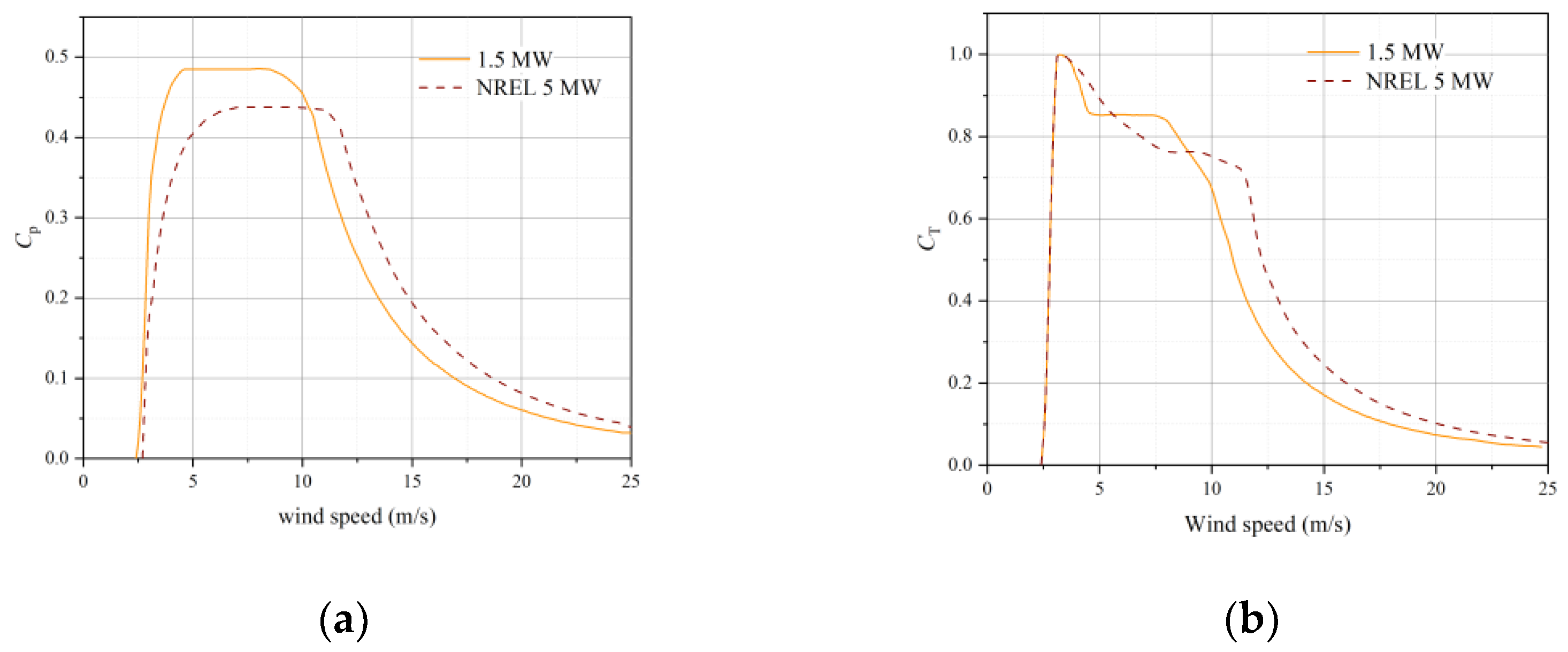
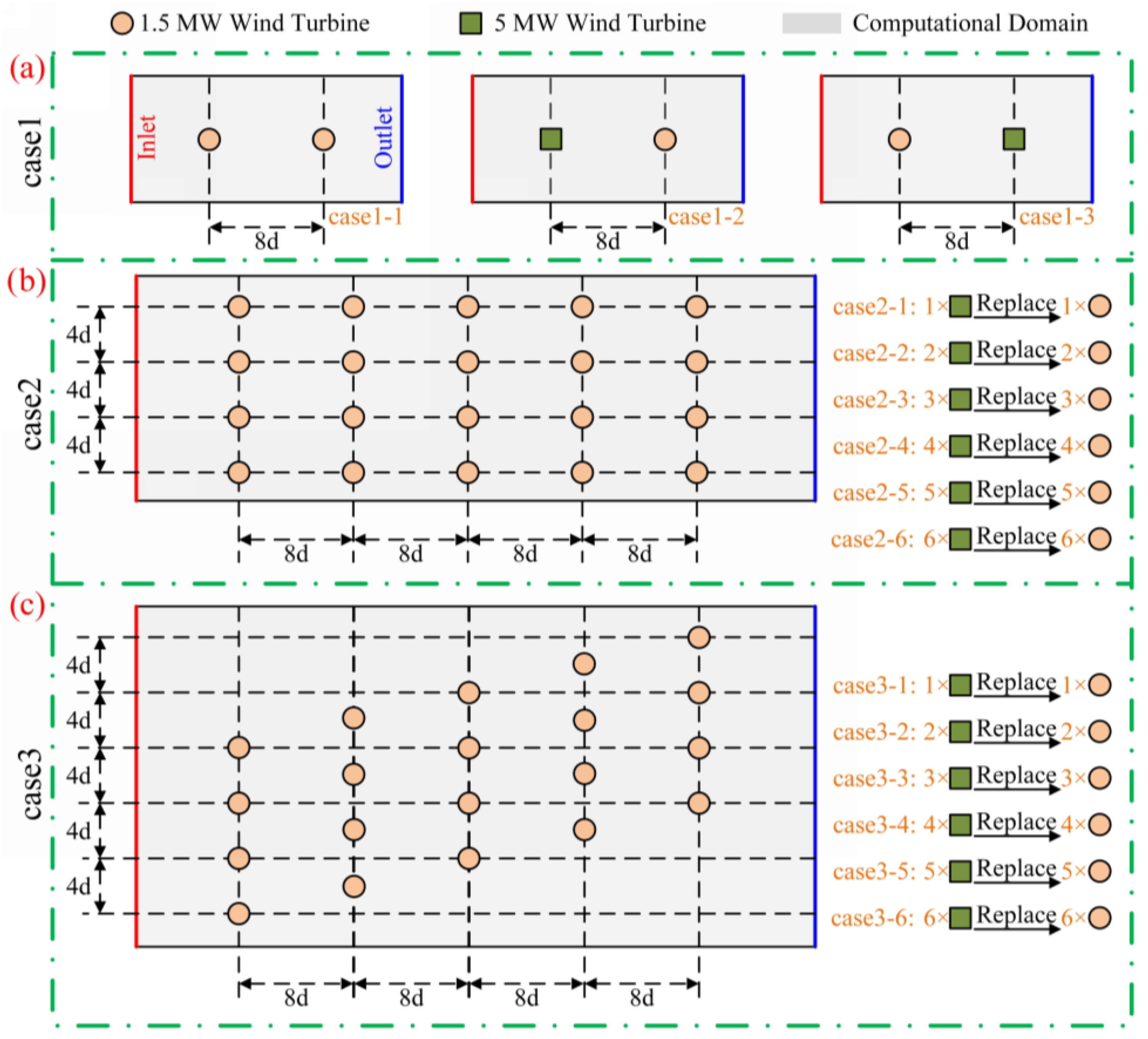
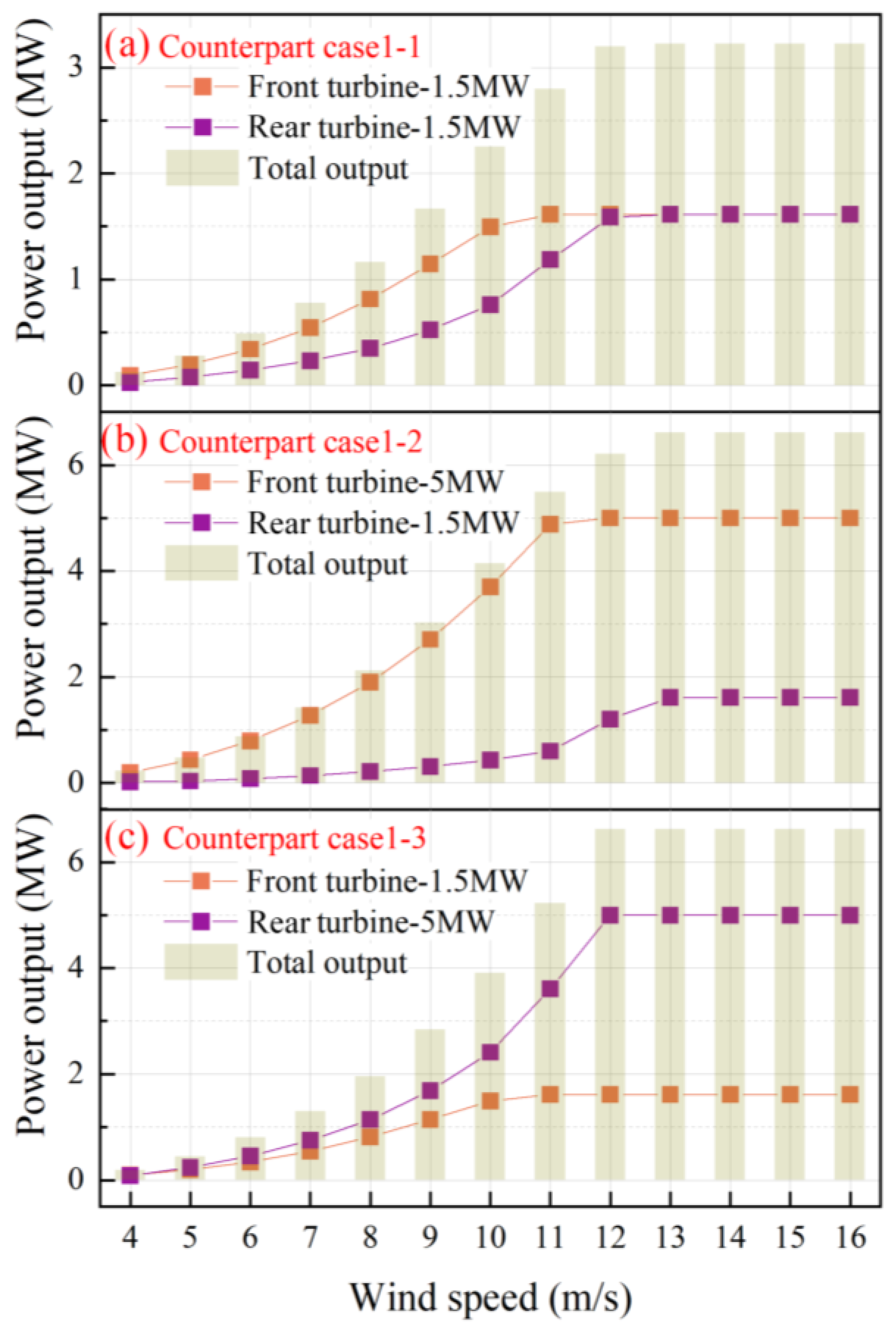
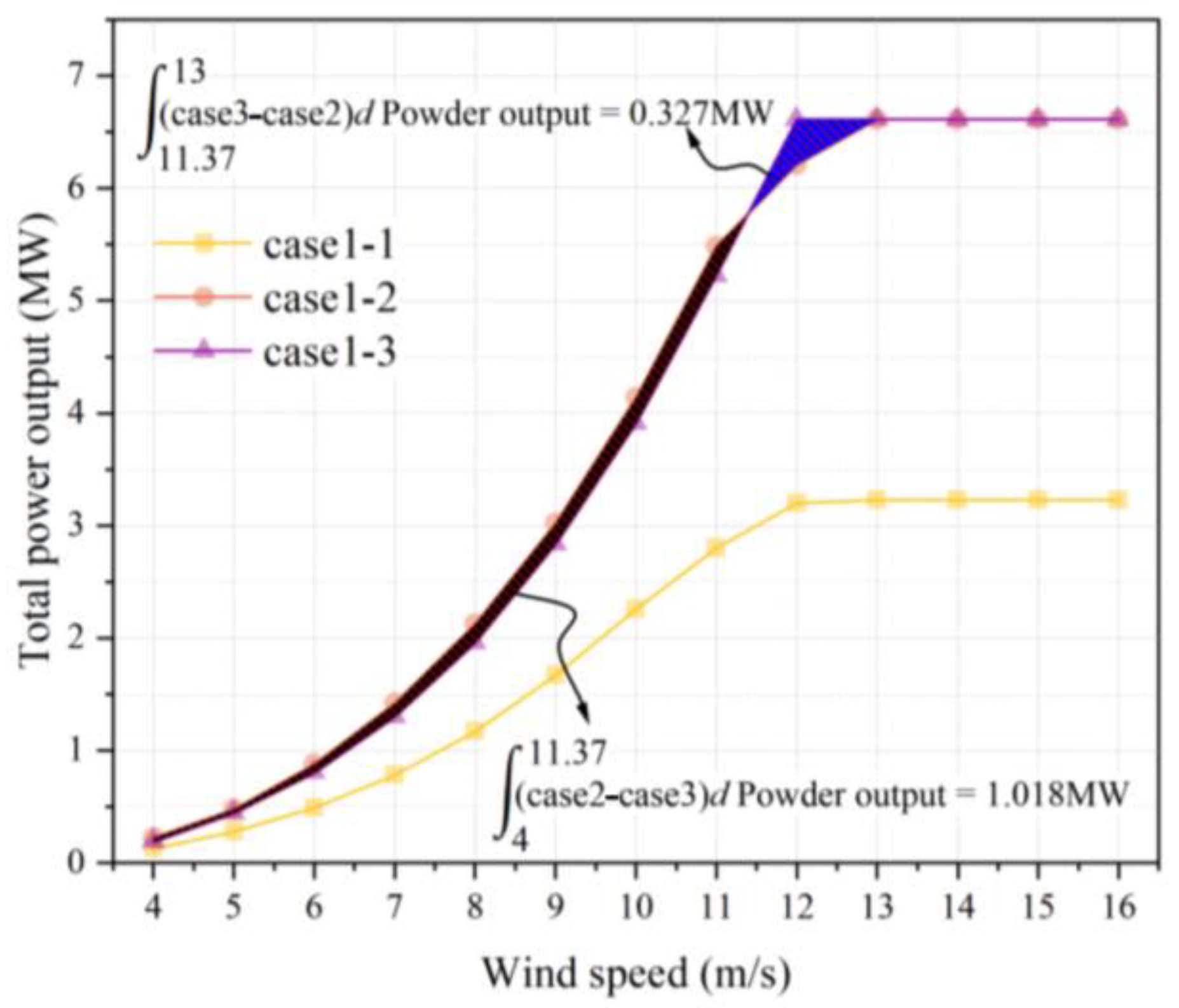
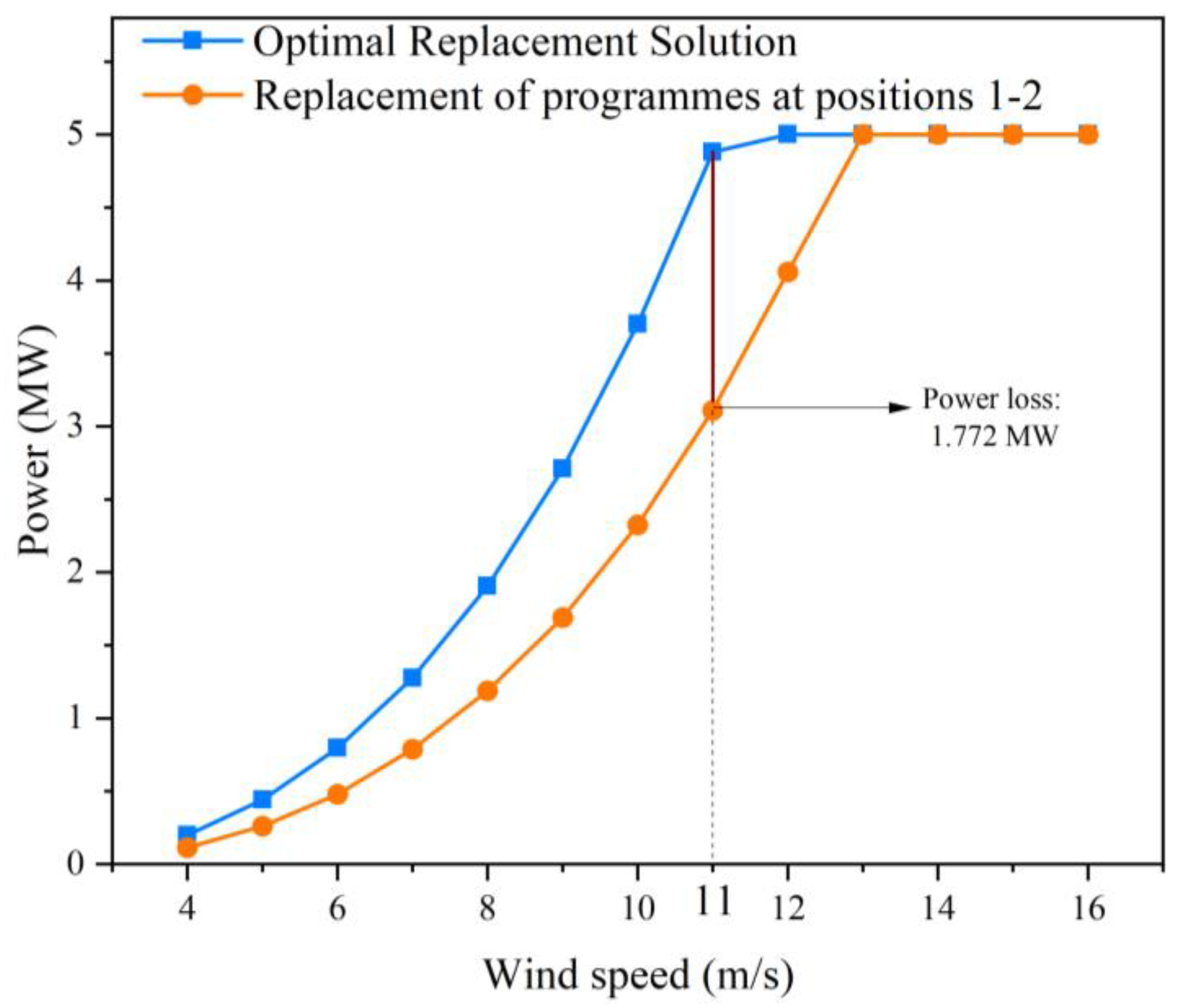
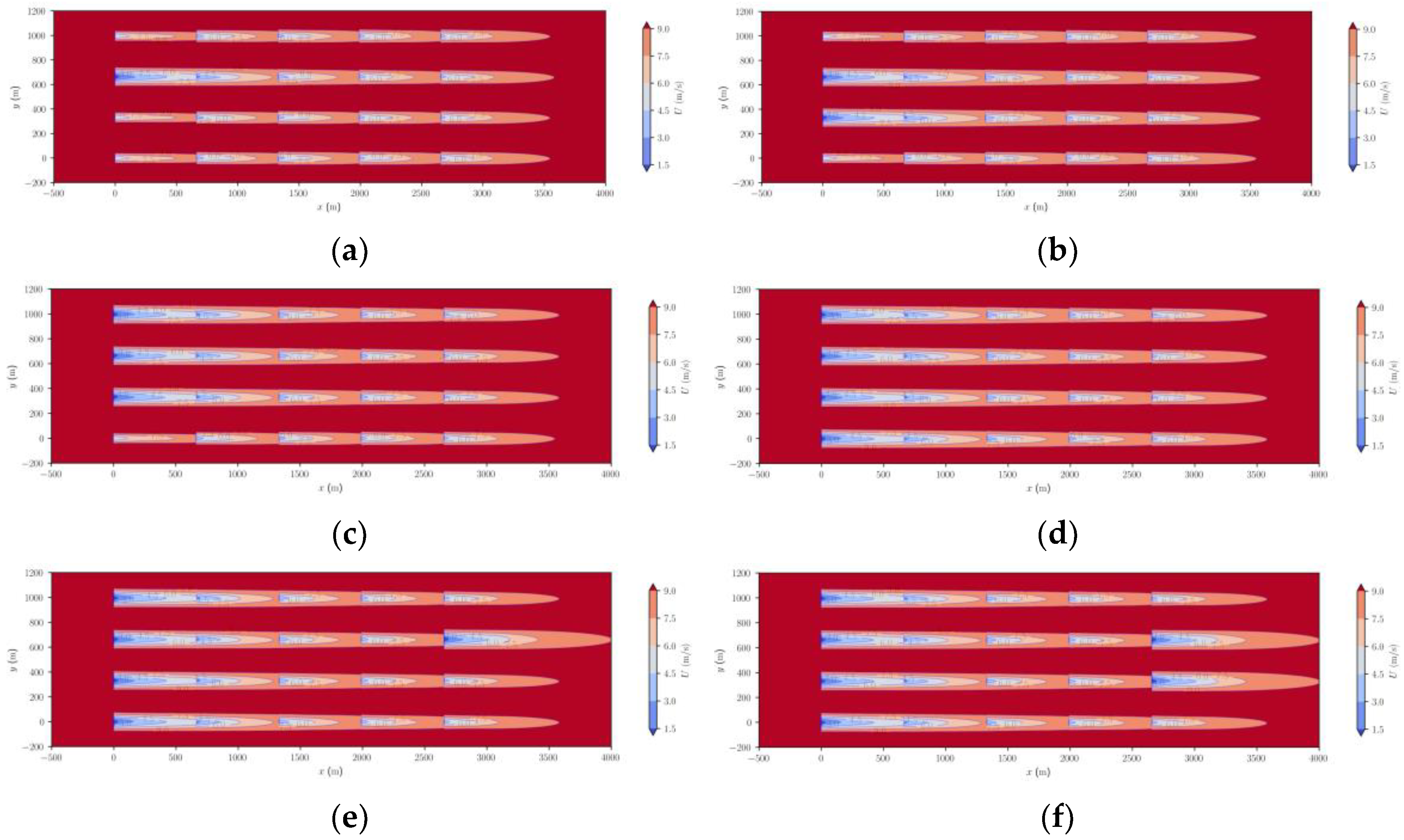
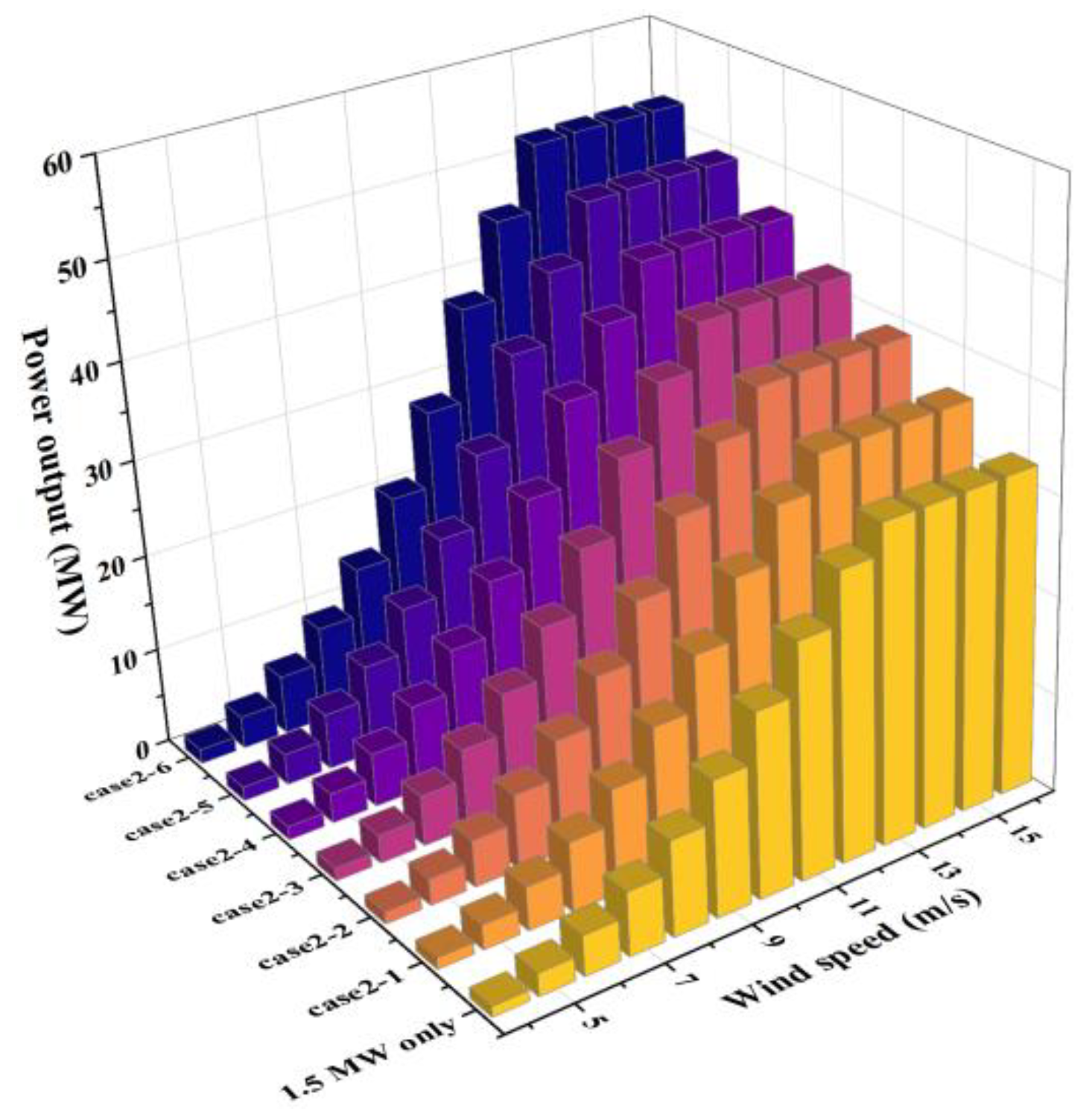
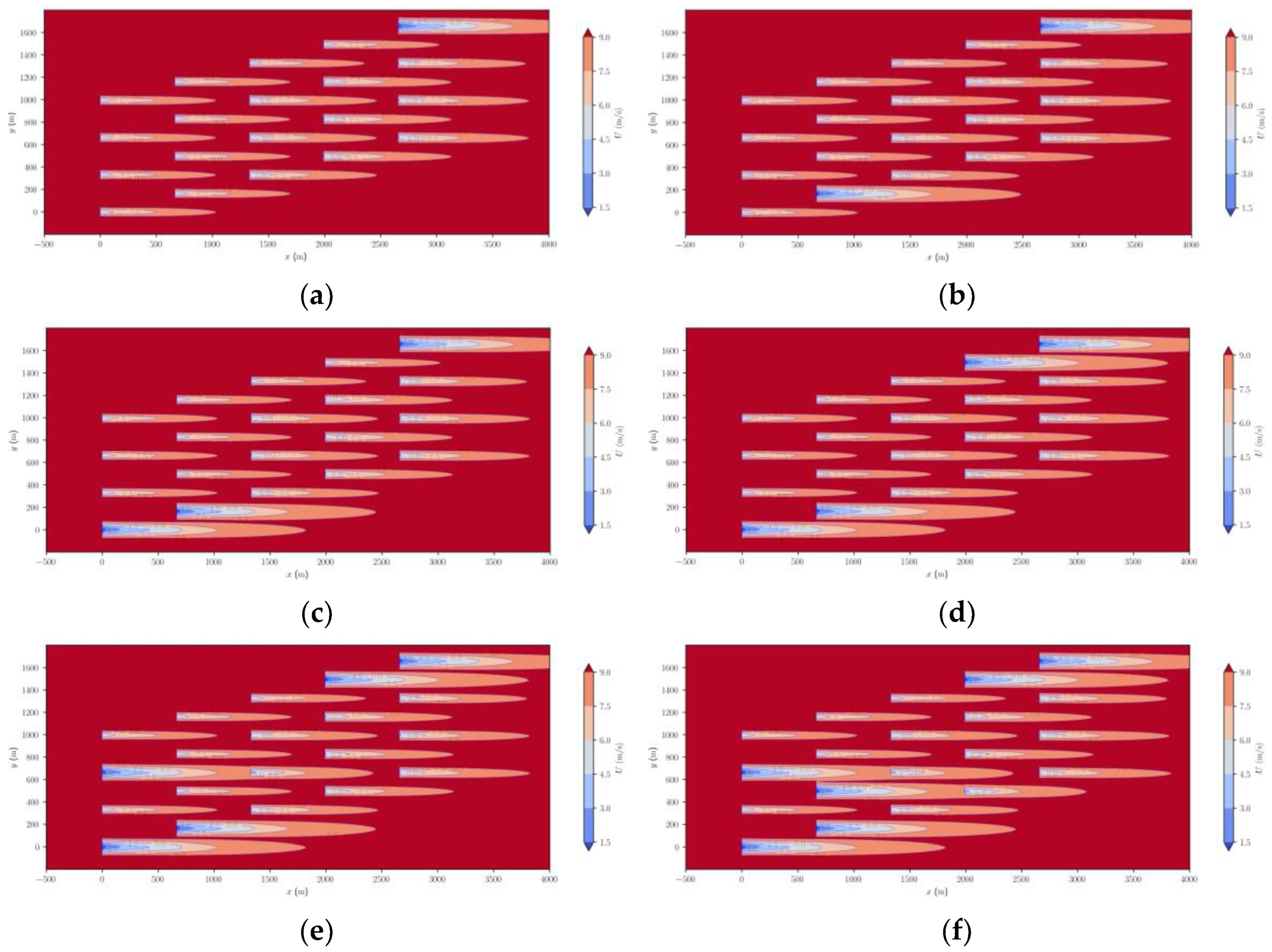

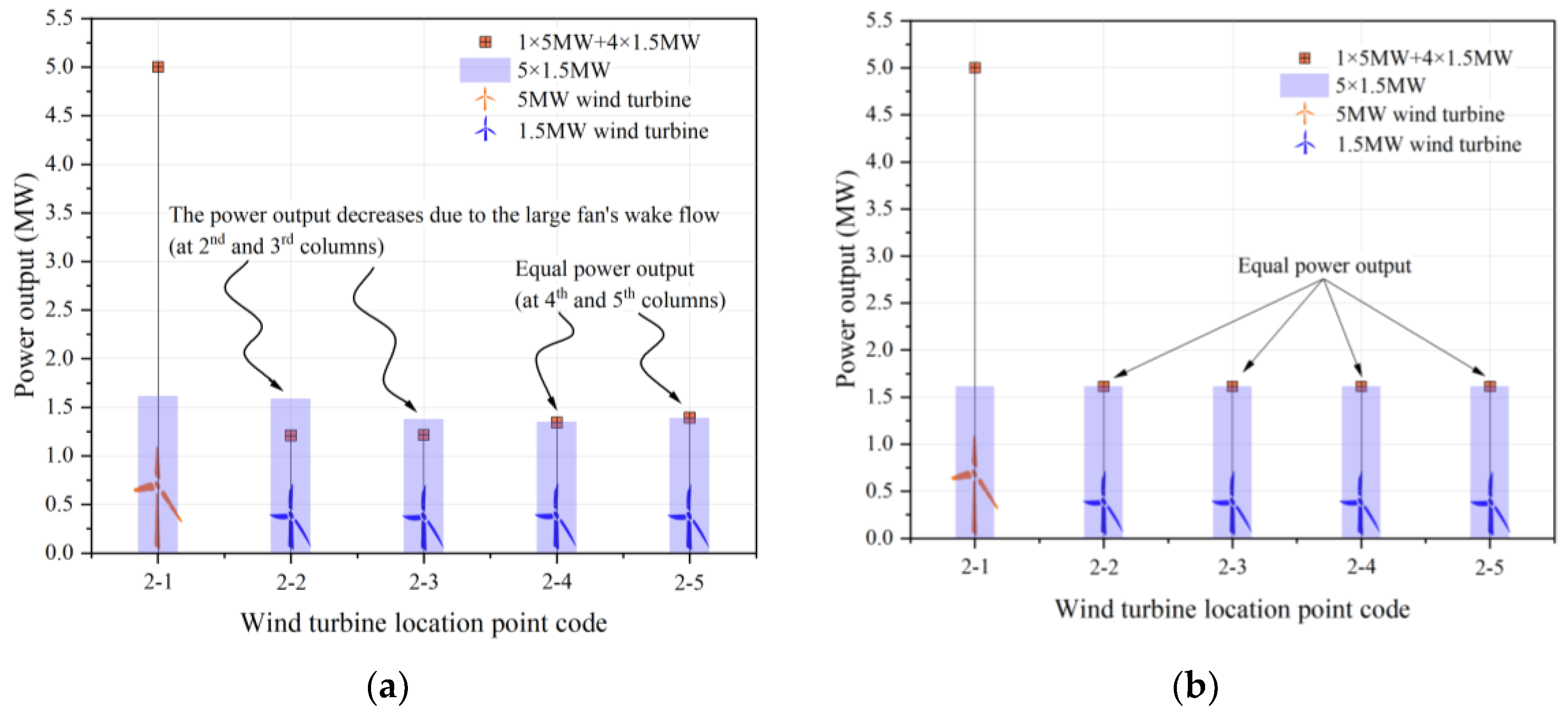
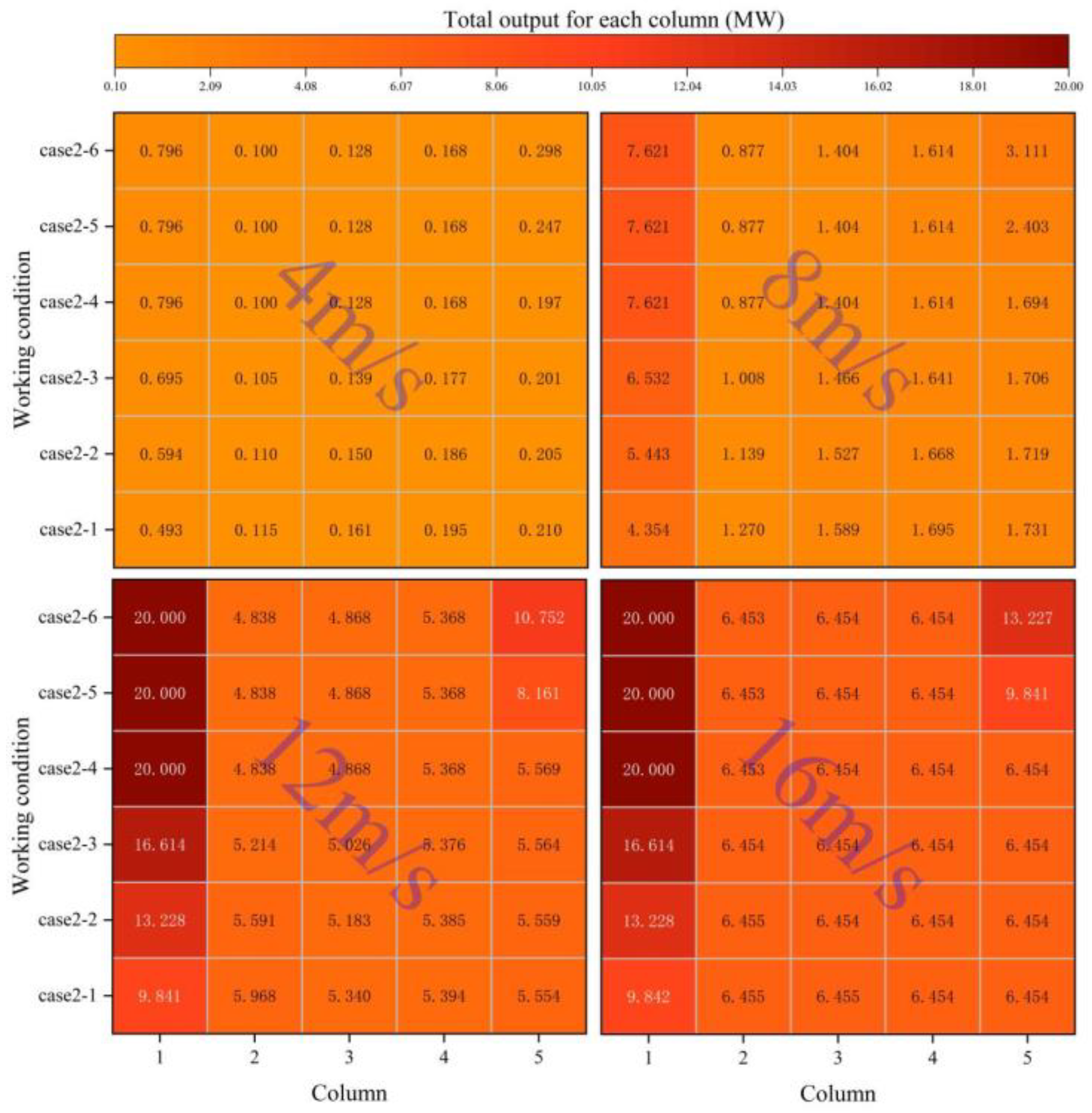
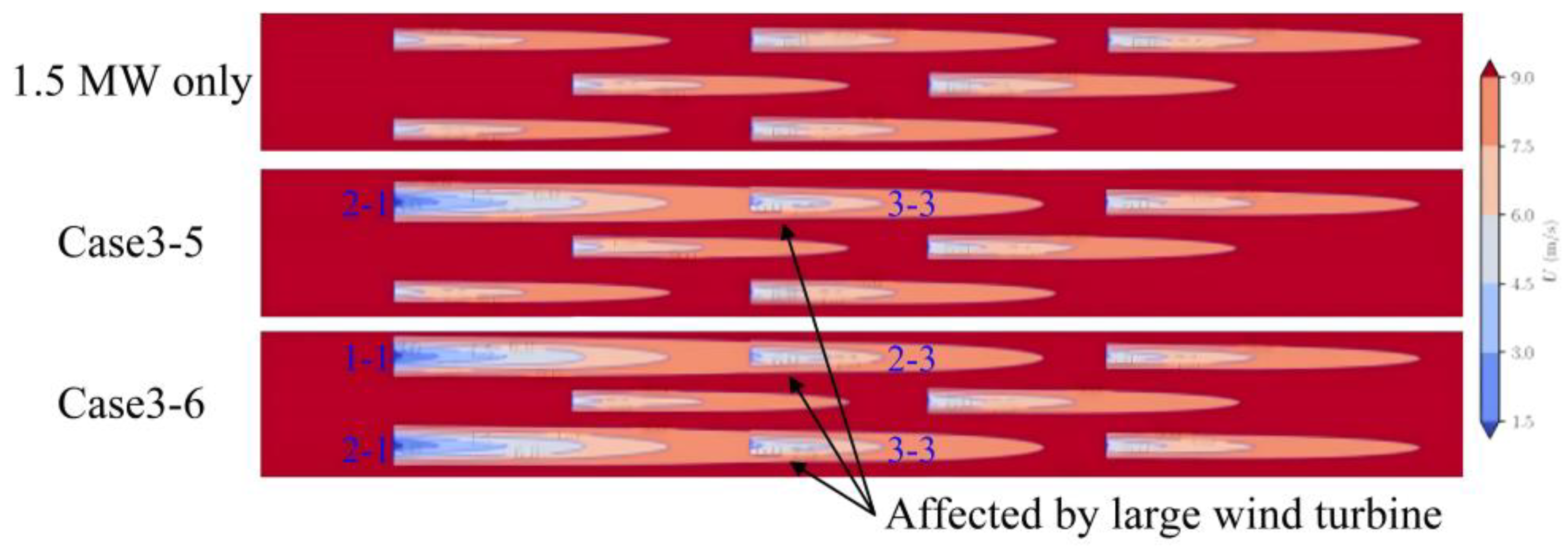
| Wind Turbine Models | Parameters | Numerical Value |
|---|---|---|
| NH 1.5 MW | Wind turbine area | 5407.87 [m2] |
| Wheel height | 65 [m] | |
| NREL 5 MW | Wind turbine area | 12,462.66 [m2] |
| Wheel height | 95 [m] |
| Sub-Processing | Number of Operations Required |
|---|---|
| Case 2-1, Case 3-1 | 20 |
| Case 2-2, Case 3-2 | 190 |
| Case 2-3, Case 3-3 | 1140 |
| Case 2-4, Case 3-4 | 4845 |
| Case 2-5, Case 3-5 | 15,504 |
| Case 2-6, Case 3-6 | 38,760 |
| Wind Speed | Point Code | Changes in Power Output (MW) | |
|---|---|---|---|
| Power Output | Power Deficit (Percentage to Max Power Output) | ||
| 12 m/s | 2-2 | 1.209 | 0.377 (23.77%) |
| 2-3 | 1.216 | 0.158 (11.50%) | |
| 2-4 | 1.341 | 0.009 (0.67%) | |
| Wind Speed | Working Condition/Point Code | Changes in Power Output (MW) | |
|---|---|---|---|
| Power Output | Power Deficit (Percentage of Decline) | ||
| 4 m/s | Case 3-5: 3-3; Case 3-6: 2-3, 3-3 | 0.042 | 0.018 (30.00%) |
| 8 m/s | 0.448 | 0.118 (20.81%) | |
| 12 m/s | 1.596 | 0.018 (1.12%) | |
| 16 m/s | 1.613 | 0 (0) | |
Disclaimer/Publisher’s Note: The statements, opinions and data contained in all publications are solely those of the individual author(s) and contributor(s) and not of MDPI and/or the editor(s). MDPI and/or the editor(s) disclaim responsibility for any injury to people or property resulting from any ideas, methods, instructions or products referred to in the content. |
© 2024 by the authors. Licensee MDPI, Basel, Switzerland. This article is an open access article distributed under the terms and conditions of the Creative Commons Attribution (CC BY) license (https://creativecommons.org/licenses/by/4.0/).
Share and Cite
Tian, W.; Wei, F.; Zhao, Y.; Wan, J.; Zhao, X.; Liu, L.; Zhang, L. A Numerical Investigation of the Influence of the Wake for Mixed Layout Wind Turbines in Wind Farms Using FLORIS. J. Mar. Sci. Eng. 2024, 12, 1714. https://doi.org/10.3390/jmse12101714
Tian W, Wei F, Zhao Y, Wan J, Zhao X, Liu L, Zhang L. A Numerical Investigation of the Influence of the Wake for Mixed Layout Wind Turbines in Wind Farms Using FLORIS. Journal of Marine Science and Engineering. 2024; 12(10):1714. https://doi.org/10.3390/jmse12101714
Chicago/Turabian StyleTian, Wenxin, Fulong Wei, Yuze Zhao, Jiawei Wan, Xiuyong Zhao, Langtong Liu, and Lidong Zhang. 2024. "A Numerical Investigation of the Influence of the Wake for Mixed Layout Wind Turbines in Wind Farms Using FLORIS" Journal of Marine Science and Engineering 12, no. 10: 1714. https://doi.org/10.3390/jmse12101714







